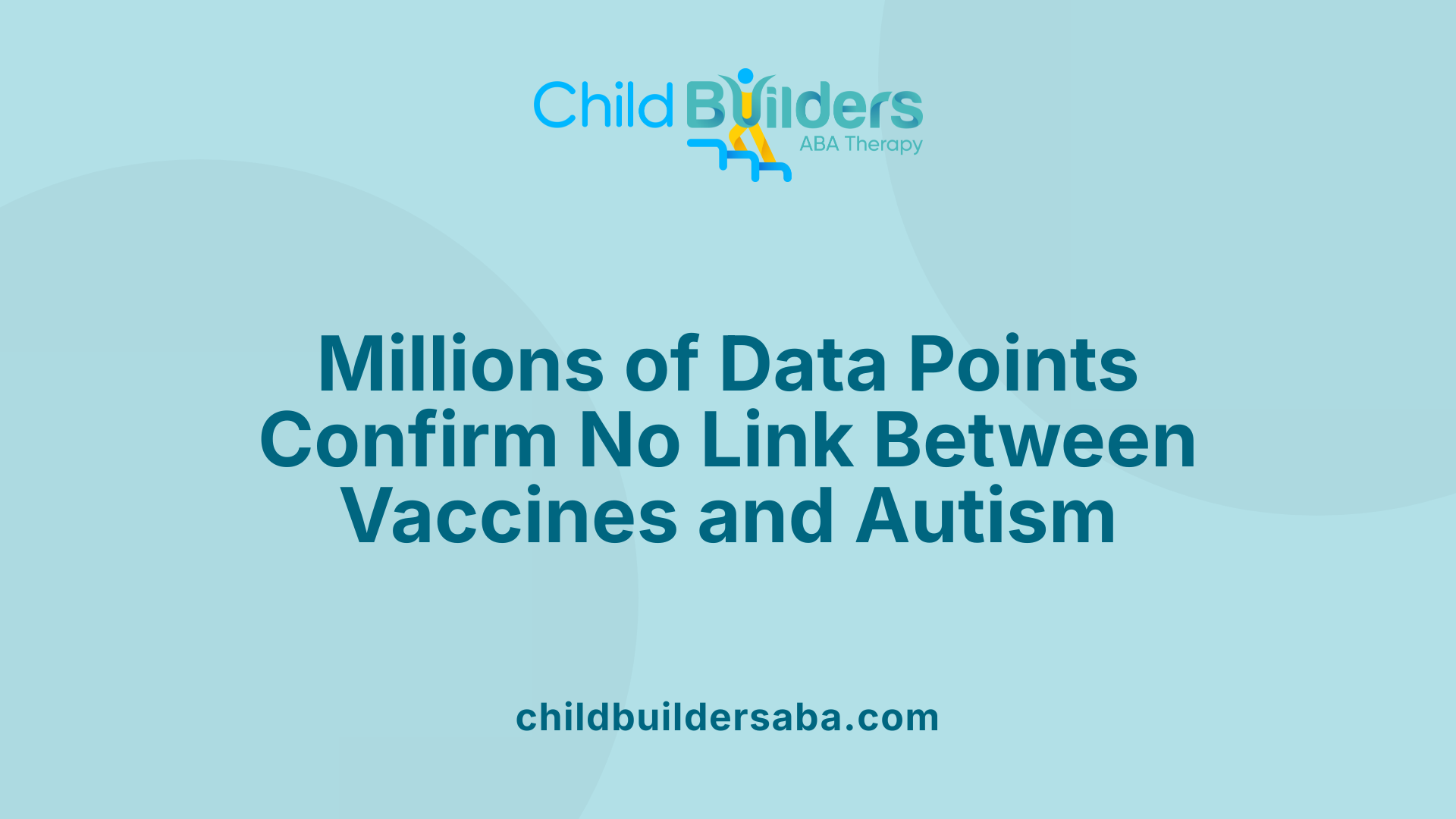Do Vaccines Cause Autism?

Understanding the Scientific Consensus on Vaccines and Autism
The question of whether vaccines cause autism has been a source of concern and misinformation for decades. Despite persistent rumors and sensational headlines, extensive scientific research has consistently demonstrated that vaccines do not cause autism. This article explores the origins of the vaccine-autism myth, reviews the overwhelming scientific evidence, and clarifies the facts for informed decision-making.
The Origins and Discrediting of the Wakefield Study

Was there a 1998 paper suggesting a link between MMR vaccine and autism?
In 1998, Andrew Wakefield published a study that claimed a possible connection between the MMR vaccine and autism. This paper gained significant attention and sparked fears among parents worldwide.
What were the scientific issues with Wakefield's study?
However, this study was later found to be fundamentally flawed. Investigations revealed serious methodological errors, such as a small sample size and lack of proper controls. More critically, Wakefield's research was marred by misconduct; he had undisclosed financial conflicts of interest and manipulated data to support his hypothesis. These ethical breaches called the validity of his findings into question.
Was the study retracted, and what happened to Wakefield?
As a result of these problems, The Lancet, the journal that published Wakefield's paper, retracted it in 2010. Further scrutiny led to Wakefield losing his medical license, and he faced widespread condemnation across the scientific community.
Are there any credible scientific studies linking vaccines to autism?
Extensive research has consistently found no credible evidence linking vaccines to autism. Large epidemiological studies from around the world, involving hundreds of thousands of children, have shown no association. Meta-analyses in this field — which compile data from multiple studies — support this conclusion.
Why is it believed that vaccines do not cause autism?
Most importantly, the scientific consensus is clear: vaccines, including MMR and those containing thimerosal, do not cause autism. The supposed link suggested by Wakefield's discredited study has been thoroughly debunked. The increase in autism diagnoses over recent decades is attributed to better diagnostic criteria and increased awareness rather than vaccination practices.
What is the current stance of health authorities on this issue?
Health agencies like the CDC, the American Academy of Pediatrics, and the Institute of Medicine have reviewed existing evidence comprehensively. They affirm that vaccines are safe and not associated with autism. The myth that vaccines cause autism persists in part due to misinformation, but scientific evidence consistently supports vaccination as safe.
| Aspect | Details | Additional Information |
|---|---|---|
| Original Study | Published in 1998 | Suggested a link between MMR and autism |
| Flaws | Small sample size, lack of controls | Data manipulation, ethical issues |
| Retraction | 2010 by The Lancet | Due to misconduct and falsification |
| Wakefield’s License | Revoked | Disqualified from practicing medicine |
| Scientific Consensus | No link between vaccines and autism | Based on large-scale studies and reviews |
| Causes of Autism | Genetic factors, environmental influences | Not vaccines |
| Impact of Wakefield's Study | Caused vaccine hesitancy | Still influences misinformation |
This history underscores the importance of relying on rigorous scientific research and the critical need to discredit false claims that can endanger public health.
Extensive Global Research Shows No Link Between Vaccines and Autism
 Numerous large epidemiological studies conducted internationally have consistently shown that vaccines do not cause autism. These studies involve huge populations, providing robust evidence to dispel myths linking immunizations to developmental disorders.
Numerous large epidemiological studies conducted internationally have consistently shown that vaccines do not cause autism. These studies involve huge populations, providing robust evidence to dispel myths linking immunizations to developmental disorders.
Major research efforts, including those analyzing data from over 650,000 children in Denmark, more than 95,000 children in the United States, and 537,000 children in Denmark, have found no increased risk of autism associated with the MMR vaccine. These studies carefully examine vaccination timelines and health outcomes, showing no correlation between receiving vaccines and the development of autism spectrum disorder (ASD).
Research on vaccine ingredients, such as thimerosal—a mercury-based preservative used in some vaccines—also supports this conclusion. Multiple studies, including meta-analyses involving over 1.2 million children, have shown no connection between thimerosal exposure and autism. The removal of thimerosal from most childhood vaccines in the U.S. in 2001 did not lead to any decline in autism rates, further indicating no link.
Studies examining vaccination schedules, including the number of vaccines given at once, have repeatedly demonstrated that these factors do not influence autism development. Research published in reputable journals like JAMA and reviews by the Institute of Medicine have affirmatively stated that the extensive evidence favors rejecting any causal relationship.
This wealth of research underscores that vaccines, including MMR and those with thimerosal, are safe and not associated with autism. Concerns often stem from coincidental timing, as autism symptoms typically emerge around when children receive their vaccinations. However, scientific data confirms that autism develops from genetic and prenatal environmental factors, not immunizations.
In conclusion, the overwhelming body of global scientific research shows no causal link between vaccines and autism, reinforcing that immunization remains a critical public health tool for preventing serious infectious diseases.
Vaccine Ingredients and Autism: What the Science Tells Us
What are some common misconceptions about vaccines and autism?
Many people believe that vaccines, especially their ingredients like mercury, formaldehyde, or aluminum, are harmful or cause autism. These misconceptions have led to unwarranted fears and vaccine hesitancy.
One widespread myth is that vaccine ingredients contain dangerous substances or microchips used for tracking. In reality, vaccines are carefully tested and monitored for safety. They do not contain microchips or other harmful components.
A significant misconception concerns the presence of mercury, specifically in the form of thimerosal. Thimerosal was used as a preservative in some vaccines but has been removed from most childhood vaccines in the United States since 2001. This removal was based on safety reviews and public concern, although scientific evidence indicates that thimerosal does not cause autism.
Similarly, ingredients like formaldehyde and aluminum, which are used in small amounts in vaccines to stabilize the vaccine and enhance immune response, are naturally occurring and present in many everyday foods and products. For example, formaldehyde is produced by the human body naturally, and aluminum is commonly found in antacids and certain foods.
Thimerosal and its removal from vaccines
Thimerosal, a mercury-based preservative, was used to prevent bacterial and fungal growth in multi-dose vaccine vials. Extensive research has been conducted on its safety; studies consistently show that thimerosal does not cause autism.
Multiple large-scale studies, including those analyzing data from hundreds of thousands of children worldwide, have shown no link between thimerosal exposure and autism risk. For instance, after the removal of thimerosal from most vaccines in 2001, autism rates did not decrease, further supporting the lack of association.
The safety of other vaccine ingredients like formaldehyde and aluminum
Formaldehyde is used minimally in some vaccine production processes to inactivate toxins and pathogens. The small quantities used are much lower than what is naturally found in human tissue and food.
Aluminum salts are included as adjuvants to boost vaccine effectiveness. The amounts used are minimal—much less than that found in common foods—yet they have undergone rigorous safety testing.
Studies evaluating vaccine ingredients and autism risk
Research involving millions of children across various countries has consistently found no evidence that vaccine components like thimerosal, formaldehyde, or aluminum contribute to autism.
Meta-analyses reviewing more than 1.2 million children’s data have reaffirmed these findings. For example, a 2013 CDC study examining the number of antigens (substances that stimulate immune responses) in vaccines found no difference in autism rates between children with varying vaccine exposures.
Overall, the scientific consensus is clear: vaccine ingredients are safe, and there is no credible link between any of these components and autism spectrum disorder. The focus remains on verifying the safety and effectiveness of vaccines through continual research and monitoring.
Here's a summary table to clarify the facts about vaccine ingredients:
| Ingredient | Common Use in Vaccines | Natural Occurrence | Scientific Findings on Autism Link |
|---|---|---|---|
| Thimerosal | Preservative in multi-dose vaccines (mostly removed) | Yes, as mercury | No association with autism proven by large studies |
| Formaldehyde | Inactivating toxins during vaccine production | Yes, in human tissues | No evidence of causing autism |
| Aluminum | Adjuvant to improve immune response | Yes, in foods and medicines | Minimal amounts; no link to autism |
This information confirms that current vaccine formulations are safe and do not contribute to autism development. Ongoing research ensures safety standards are maintained, allowing vaccinations to remain a cornerstone of public health.
Genetics, Early Development, and Autism: The Underlying Factors
What does the scientific research say about the link between vaccines and autism?
Extensive scientific studies have consistently shown no evidence that vaccines cause autism spectrum disorder (ASD). Large-scale research from multiple countries, involving hundreds of thousands of children, has repeatedly demonstrated that neither the ingredients in vaccines, such as thimerosal and aluminum, nor the timing of vaccination, increase autism risk.
The now-discredited 1998 study by Andrew Wakefield falsely claimed a link between the MMR vaccine and autism. This paper was later retracted due to ethical breaches, flawed methodology, and scientific misconduct. Subsequent research, which includes systematic reviews and meta-analyses by independent experts and organizations like the Institute of Medicine and WHO, has found no causal relationship between vaccination and autism.
Studies analyze various aspects such as vaccine ingredients and the number of vaccines given at once, all of which show no association with autism risk. For example, research in Denmark involving over 650,000 children and studies in the United States with more than 95,000 children have found no increased likelihood of autism following vaccination.
Moreover, studies on thimerosal, a mercury-based preservative used in some vaccines, have concluded it does not cause autism. Its removal from most childhood vaccines in the U.S. in 2001 did not alter autism rates, further supporting the lack of connection.
Public health sources, including the CDC and the American Academy of Pediatrics, emphasize that vaccines are safe and vital for preventing serious diseases. They also reinforce that autism development is linked primarily to genetic factors, with environmental influences such as parental age, prenatal exposures, and birth complications playing significant roles.
Overall, the overwhelming body of research confirms that vaccines are not a cause of autism. Continued investigation into the origins of ASD points to complex genetic and early neurodevelopmental factors, with no evidence supporting the vaccine-autism hypothesis.
Why Autism Diagnoses Have Increased and What It Actually Means
How has misinformation affected public perception of vaccines and autism?
Misinformation has played a significant role in shaping public fears and misconceptions about vaccines' safety, especially concerning autism. Social media platforms and unverified sources often spread false claims linking vaccines to autism, leading many parents to hesitate or refuse vaccination for their children. These claims include unfounded theories about vaccines causing infertility, altering DNA, or damaging the nervous system.
The proliferation of conspiracy theories involving secret societies and hidden motives has further eroded trust in health authorities and vaccine manufacturers. This misinformation creates a cycle of confusion and fear, despite overwhelming scientific evidence showing no connection between vaccines and autism.
As a result, vaccine hesitancy increases, causing decreased vaccination rates. This decline can lead to outbreaks of diseases that had previously been under control, such as measles. Public health organizations like the CDC and the American Academy of Pediatrics emphasize that vaccines are safe and effective, but combating misinformation remains challenging.
Efforts such as fact-checking, community outreach, and educational campaigns aim to counteract false narratives. Nevertheless, the influence of misinformation persists and continues to impact vaccination decisions, with significant implications for community health and the protection of vulnerable populations.
What does the rise in autism diagnoses actually mean?
The apparent increase in autism diagnoses over recent decades does not indicate a true rise in the number of cases. Instead, this trend is largely attributed to broader diagnostic criteria, increased awareness, and improved screening methods.
Diagnostic criteria for autism spectrum disorder (ASD) have expanded, allowing more individuals with subtle symptoms to be identified. Enhanced awareness among healthcare providers and parents has led to earlier and more frequent diagnoses.
Advances in screening tools, along with societal acceptance and reduced stigma, have encouraged more families to seek assessments. For example, more children than ever are being diagnosed at younger ages, often before age three.
Environmental factors, such as advanced parental age, prenatal exposure to pollutants or pesticides, maternal health issues, and birth complications, are associated with increased autism risk. However, these factors do not explain the rise in diagnoses as much as changes in clinical practices and awareness.
Overall, the increase reflects better recognition of autism rather than an actual surge in prevalence. The scientific consensus maintains that autism results from complex genetic and environmental interactions, and ongoing research continues to explore these influences.
| Aspect | Explanation | Additional Details |
|---|---|---|
| Broader diagnostic criteria | More inclusive definitions include mild and atypical cases | Led to increased reported prevalence |
| Increased awareness | More providers and parents recognizing signs | Earlier detection and intervention |
| Improved screening | Advanced tools for early detection | Facilitates diagnosis at younger ages |
| Environmental influences | Factors such as parental age, pollution, maternal health | Might contribute but do not fully explain rise |
This comprehensive understanding underscores that increased diagnosis is primarily a reflection of improved detection and awareness, not an actual increase in cases.
The Clear Scientific Consensus and the Importance of Vaccination
Decades of rigorous research and countless studies confirm that vaccines do not cause autism. The persistence of myths and misinformation undermines public health efforts and puts vulnerable populations at risk. It is essential to rely on scientific evidence and trusted health authorities for accurate information. Vaccination remains one of the most effective ways to protect individual and community health, prevent deadly diseases, and improve overall quality of life worldwide.
References
- The Evidence on Vaccines and Autism | Johns Hopkins
- Do vaccines cause autism? - Autism Speaks
- Autism and Vaccines - CDC
- Here is how we know that vaccines do not cause autism - STAT News
- Frequently Asked Questions about Autism Spectrum Disorder - CDC
- Vaccines and Autism | Children's Hospital of Philadelphia
- Is There a Connection Between Vaccines and Autism? - Kids Health





































































































